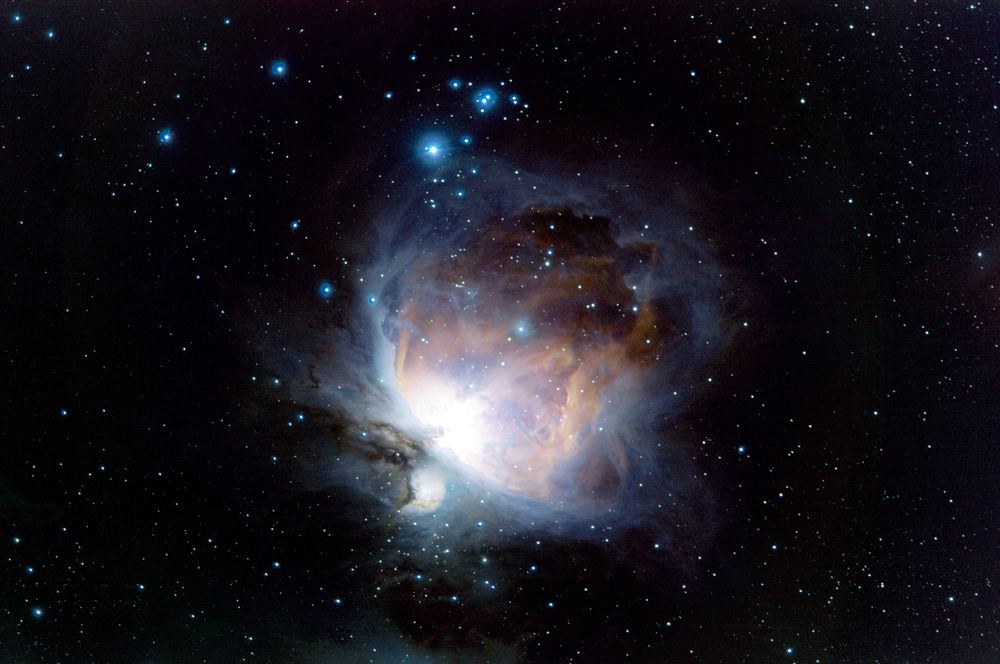Siding Spring Observatory welcomes new telescope
Oliver Brown
22 July 2022, 3:50 AM
 Highly-regarded astronomer Professor Fred Watson AM with the Huntsman Telescope PhD Candidate team Fergus Longbottom, Sarah Caddy and Jaime Alvarado-Montes and the telescope itself at Siding Spring Observatory. Image: Megan Hoole, Macquarie University.
Highly-regarded astronomer Professor Fred Watson AM with the Huntsman Telescope PhD Candidate team Fergus Longbottom, Sarah Caddy and Jaime Alvarado-Montes and the telescope itself at Siding Spring Observatory. Image: Megan Hoole, Macquarie University.AN EXCITING new astronomy project at the Siding Spring Observatory (SSO) near Coonabarabran has begun its investigations of the stars earlier this week.
The 'Huntsman' telescope, which started operating on Wednesday 20 July, is one of very few in the world so far which has been designed with non-traditional telescope technology for a very niche purpose.
The project has been in development for the better part of a decade after first being commissioned by Macquarie University Senior Lecturer and Principal Investigator Dr Lee Spitler in 2014.
"(Huntsman) was inspired by a similar telescope in America called 'Dragonfly' which came out in 2014. That's when I started to kick off the project and start gathering funding for it," Dr Spitler said.
"We first broke ground about four years ago and then it has been a fairly long construction. This has been due to various factors, from ants attacking the electric board to a lightning strike, the mice plague, plus some on the technical side.
"COVID certainly didn't help. We were ready to go about a year-and-a-half ago but then it's been held back until now. Still it's really exciting to finally have it up and running."
According to Dr Spitler, Huntsman is not your average telescope in that it is fully automated, meaning it won't open in unfavourable weather and the team using it can analyse all the data it collects remotely and have a more hands-on experience than they would with a more general telescope.
In addition, he said it doesn't use a big mirror lens, but rather off-the-shelf components, including 10 Canon photo lenses, allowing them to take high quality photos in space.
"The reason mirrors aren't so great is that they're not perfectly polished, so often you don't get the diffuse details that we're looking for," he said.
"Obviously, Dragonfly inspired us and I'm aware of at least three other places around the world making smaller versions, including one in Panama and one in Iran.

ABOVE: Macquarie University Senior Lecturer and Principal Investigator of the Huntsman Telescope Dr Lee Spitler at the Observatory. Image: Megan Hoole, Macquarie University.
"The good thing about this new wave is that we can start actually building these smaller niche telescopes more efficiently that are designed with a single purpose, meaning astronomers can use them to make a simple experiment, asking one question and trying to answer it."
Director of the SSO Dr Chris Lidman from Australian National University said a variety of factors make the area great for all sorts of telescopes.
"People who do astronomy like to observe targets 24 hours a day, every day of the year and of course you can't always do that everywhere because your sight might be blocked from view," Dr Lidman said.
"In the southern hemisphere, there's only three places to put in telescopes and Australia is one of them.
"When you have an observatory, you want to be on the top of a mountain with lots of clear weather and very little light pollution
"You also need a dark location and, in addition to filling all the other criteria, Siding Spring is located in what's known as a 'dark sky park'."
Dr Spitler said the fact it was in a dark sky park made SSO perfect for Huntsman in its designated purpose of looking at far-away galaxies.
"Our main target is galaxies. Like the Milky Way, galaxies have stars, dust, dark matter, however the trouble with our galaxy is that there's only one, so we don't know what will happen to it in the future or what happened to it in the past.
"So we're looking at other galaxies that resemble the Milky Way and seeing if any evidence of them growing by colliding and merging with other galaxies."

ABOVE: A recent image captured through the Huntsman Telescope of the Orion Nebula. Image captured by Sarah Caddy, PhD Candidate.
While Huntsman is the most recent addition to SSO, it will not be the last, with works also beginning this week for the GOTO-South telescope, a collaboration between Monash University and the UK-based University of Warwick.
Dr Lidman said the works were expected to be complete in a matter of months and other telescopes were also in the early planning stages, which was good for both SSO and the local community.
"It is a vote of confidence that organisations are wanting to build more facilities at this locations, it means the future of the observatory is secure," Dr Lidman said.
"Sighting Spring is an important tourist drawcard for the local community with it being open five days a week so it’s a vote of confidence for them as well."




